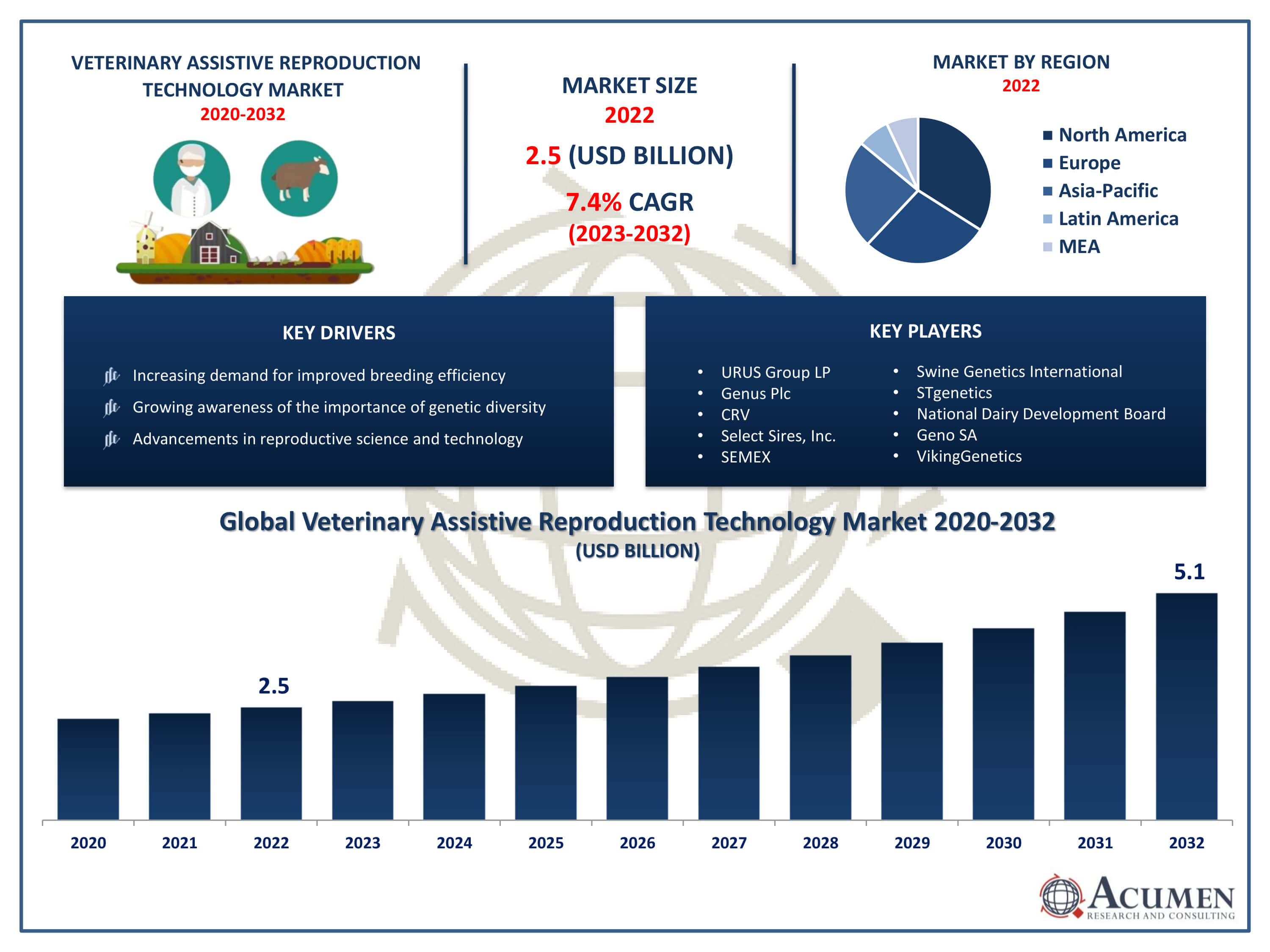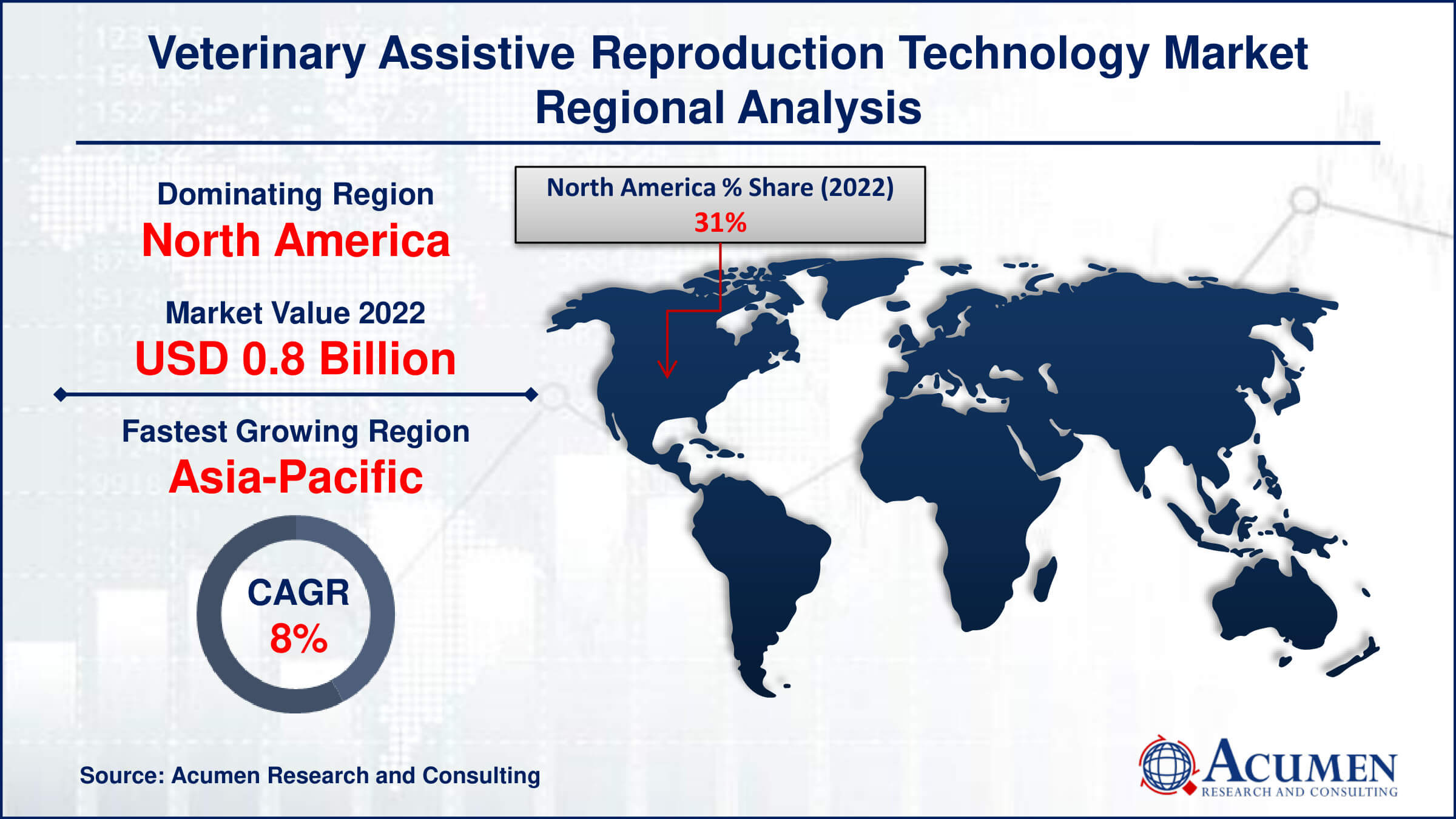Veterinary Assistive Reproduction Technology Market | Acumen Research and Consulting
Veterinary Assistive Reproduction Technology Market Size - Global Industry, Share, Analysis, Trends and Forecast 2023 - 2032
Published :
Report ID:
Pages :
Format :
The Veterinary Assistive Reproduction Technology Market Size accounted for USD 2.5 Billion in 2022 and is projected to achieve a market size of USD 5.1 Billion by 2032 growing at a CAGR of 7.4% from 2023 to 2032.
Veterinary Assistive Reproduction Technology Market Highlights
- Global Veterinary Assistive Reproduction Technology Market revenue is expected to increase by USD 5.1 Billion by 2032, with a7.4% CAGR from 2023 to 2032
- North America region led with more than 31% of Veterinary Assistive Reproduction Technology Market share in 2022
- Asia-Pacific Veterinary Assistive Reproduction Technology Market growth will record a CAGR of more than 8% from 2023 to 2032
- By animal type, the bovine segment captured more than 41% of revenue share in 2022.
- By conception method, the artificial insemination segment has held the largest market share of 88% in 2022
- Increasing demand for improved breeding efficiency, drives the Veterinary Assistive Reproduction Technology Market value

Veterinary Assisted Reproduction Technology (VART) refers to a range of advanced reproductive techniques applied to animals in the veterinary field to enhance breeding outcomes. This includes artificial insemination, in vitro fertilization, embryo transfer, and other assisted reproductive technologies commonly used in livestock, companion animals, and endangered species. VART plays a crucial role in improving genetic traits, managing reproductive challenges, and conserving valuable genetic material, contributing to the overall health and sustainability of animal populations.
The market for Veterinary Assisted Reproduction Technology has been experiencing significant growth in recent years. The increasing demand for improved breeding efficiency, the rising awareness of the importance of genetic diversity in animal populations, and advancements in reproductive science are key drivers fueling the expansion of this market. Additionally, the growing focus on companion animal health and the conservation of endangered species further contribute to the adoption of VART. As technology continues to advance, and as more veterinarians and breeders recognize the benefits of these techniques, the market for veterinary assisted reproduction technology is likely to see sustained growth in the coming years, both in terms of innovation and market share.
Global Veterinary Assistive Reproduction Technology Market Trends
Market Drivers
- Increasing demand for improved breeding efficiency
- Growing awareness of the importance of genetic diversity
- Advancements in reproductive science and technology
- Focus on companion animal health
- Conservation efforts for endangered species
Market Restraints
- High costs associated with advanced reproductive technologies
- Limited awareness and accessibility in certain regions
Market Opportunities
- Expansion of veterinary services and facilities
- Integration of precision breeding techniques
Veterinary Assistive Reproduction Technology Market Report Coverage
| Market | Soil Moisture Sensor Market |
| Soil Moisture Sensor Market Size 2022 | USD 2.5 Billion |
| Soil Moisture Sensor Market Forecast 2032 | USD 5.1 Billion |
| Soil Moisture Sensor Market CAGR During 2023 - 2032 | 7.4% |
| Soil Moisture Sensor Market Analysis Period | 2020 - 2032 |
| Soil Moisture Sensor Market Base Year |
2022 |
| Soil Moisture Sensor Market Forecast Data | 2023 - 2032 |
| Segments Covered | By Animal Type, By Product, By Conception Method, And By Geography |
| Regional Scope | North America, Europe, Asia Pacific, Latin America, and Middle East & Africa |
| Key Companies Profiled | URUS Group LP, Genus Plc, CRV, Select Sires, Inc., SEMEX, Swine Genetics International, STgenetics, National Dairy Development Board, Geno SA, and VikingGenetics. |
| Report Coverage |
Market Trends, Drivers, Restraints, Competitive Analysis, Player Profiling, Covid-19 Analysis, Regulation Analysis |
Veterinary Assisted Reproduction Technology (VART) encompasses a variety of advanced reproductive techniques applied to animals for the purpose of enhancing breeding outcomes and managing reproductive challenges. These techniques include artificial insemination, in vitro fertilization, embryo transfer, and other sophisticated methods that contribute to improved genetic traits, increased breeding efficiency, and the conservation of endangered species. VART is employed in diverse settings, ranging from livestock farming and pet breeding to wildlife conservation efforts. In livestock farming, VART allows for the rapid dissemination of superior genetic traits, resulting in improved productivity and disease resistance. In companion animal breeding, it helps address infertility issues and ensures the health and vitality of offspring. Additionally, VART plays a vital role in conservation programs by aiding in the propagation of endangered species, thereby contributing to biodiversity preservation.
The veterinary assisted reproduction technology market has witnessed robust growth in recent years, driven by a confluence of factors contributing to its expansion. The increasing demand for enhanced breeding efficiency and the pursuit of specific genetic traits in animals have fueled the adoption of advanced reproductive technologies. Moreover, a growing awareness of the significance of maintaining genetic diversity in animal populations, both for agricultural purposes and conservation efforts, has further propelled the market forward. The advancements in reproductive science and technology, including techniques such as artificial insemination, in vitro fertilization, and embryo transfer, have played a pivotal role in achieving improved breeding outcomes and addressing reproductive challenges in various animal species. Additionally, ethical considerations and regulatory complexities surrounding these technologies can impact market growth. Nevertheless, the market presents significant opportunities, driven by the rising global trends in pet ownership, an expanding network of veterinary services and facilities, and increased investments in animal health research and development.
Veterinary Assistive Reproduction Technology Market Segmentation
The global Veterinary Assistive Reproduction Technology Market segmentation is based on animal type, product, conception method, and geography.
Veterinary Assistive Reproduction Technology Market By Animal Type
- Bovine
- Ovine
- Swine
- Equine
- Caprine
- Other
According to the veterinary assistive reproduction technology industry analysis, the bovine segment accounted for the largest market share in 2022. Bovine reproduction plays a critical role in the global food supply chain, and as farmers seek to optimize breeding outcomes and genetic traits in their cattle herds, they are increasingly turning to technologies such as artificial insemination and embryo transfer. These methods enable farmers to enhance the quality and productivity of their livestock, contributing to improved meat and dairy production. Key drivers for the growth of the bovine segment in the VART market include the rising demand for high-quality beef and dairy products, as well as the need to address challenges in reproductive efficiency within cattle herds. Additionally, advancements in biotechnology and reproductive science have led to more precise and efficient breeding strategies, further boosting the adoption of assisted reproductive technologies among cattle breeders.
Veterinary Assistive Reproduction Technology Market By Product
- Normal Semen
- Sexed Semen
In terms of products, the normal semen segment is expected to witness significant growth in the coming years. This growth is driven by its crucial role in optimizing breeding outcomes in various animal species. Normal semen refers to the use of high-quality sperm for artificial insemination, a technique widely employed in both livestock and companion animals to enhance reproductive efficiency and genetic traits. The growth of this segment is closely tied to the increasing awareness among breeders and veterinarians about the impact of semen quality on successful reproduction and the overall health of animal populations. Key factors propelling the growth of the normal semen segment include advancements in sperm processing techniques, ensuring the selection and use of viable and genetically superior sperm for artificial insemination. As the demand for improved breeding efficiency continues to rise, particularly in livestock production, breeders are increasingly relying on normal semen to achieve desired traits in offspring.
Veterinary Assistive Reproduction Technology Market By Conception Method
- Artificial Insemination
- IVF
- Embryo Transfer (MOET)
According to the veterinary assistive reproduction technology market forecast, the artificial insemination segment is expected to witness significant growth in the coming years. Artificial insemination involves the introduction of carefully selected and processed sperm into the reproductive tract of a female animal to facilitate fertilization. This technique is extensively used in both livestock and companion animals to enhance breeding efficiency, improve genetic traits, and overcome reproductive challenges. The growth of the AI segment is driven by its proven effectiveness in increasing the reproductive success of animals, leading to improved productivity in livestock and better breeding outcomes in companion animals. One of the key factors contributing to the growth of the AI segment is the increasing awareness among breeders and veterinarians about its advantages, such as the ability to use genetic material from superior sires and the mitigation of diseases associated with natural mating.
Veterinary Assistive Reproduction Technology Market Regional Outlook
North America
- U.S.
- Canada
Europe
- U.K.
- Germany
- France
- Spain
- Rest of Europe
Asia-Pacific
- India
- Japan
- China
- Australia
- South Korea
- Rest of Asia-Pacific
Latin America
- Brazil
- Mexico
- Rest of Latin America
The Middle East & Africa
- South Africa
- GCC Countries
- Rest of the Middle East & Africa (ME&A)

Veterinary Assistive Reproduction Technology Market Regional Analysis
North America has emerged as a dominating region in the veterinary-assisted reproduction technology (VART) market due to a combination of factors that position the region at the forefront of technological advancements and the adoption of advanced reproductive techniques in animal breeding. One of the key drivers of North America's dominance is the well-established infrastructure for veterinary care and research, supported by a robust network of veterinary clinics, research institutions, and industry players. The region boasts a highly skilled workforce of veterinarians and researchers who actively contribute to the development and application of cutting-edge reproductive technologies, including artificial insemination, in vitro fertilization, and embryo transfer. Furthermore, the North American agricultural landscape places a strong emphasis on livestock production, with a focus on optimizing breeding outcomes to meet the demands of the meat and dairy industries. This heightened focus on improving genetic traits, reproductive efficiency, and overall animal health has led to a widespread adoption of veterinary-assisted reproductive technologies. Additionally, the region's progressive regulatory environment and greater awareness among farmers and breeders about the benefits of VART contribute to the market's dominance.
Veterinary Assistive Reproduction Technology Market Player
Some of the top veterinary assistive reproduction technology market companies offered in the professional report include URUS Group LP, Genus Plc, CRV, Select Sires, Inc., SEMEX, Swine Genetics International, STgenetics, National Dairy Development Board, Geno SA, and VikingGenetics.
Frequently Asked Questions
How big is the veterinary assistive reproduction technology market?
The veterinary assistive reproduction technology market size was USD 2.5 Billion in 2022.
What is the CAGR of the global veterinary assistive reproduction technology market from 2023 to 2032?
The CAGR of veterinary assistive reproduction technology is 7.4% during the analysis period of 2023 to 2032.
Which are the key players in the veterinary assistive reproduction technology market?
The key players operating in the global market are including URUS Group LP, Genus Plc, CRV, Select Sires, Inc., SEMEX, Swine Genetics International, STgenetics, National Dairy Development Board, Geno SA, and VikingGenetics.
Which region dominated the global veterinary assistive reproduction technology market share?
North America held the dominating position in veterinary assistive reproduction technology industry during the analysis period of 2023 to 2032.
Which region registered fastest CAGR from 2023 to 2032?
Asia-Pacific region exhibited fastest growing CAGR for market of veterinary assistive reproduction technology during the analysis period of 2023 to 2032.
What are the current trends and dynamics in the global veterinary assistive reproduction technology industry?
The current trends and dynamics in the veterinary assistive reproduction technology industry include increasing demand for improved breeding efficiency, growing awareness of the importance of genetic diversity, and advancements in reproductive science and technology.
Which product held the maximum share in 2022?
The normal semen product held the maximum share of the veterinary assistive reproduction technology industry.


